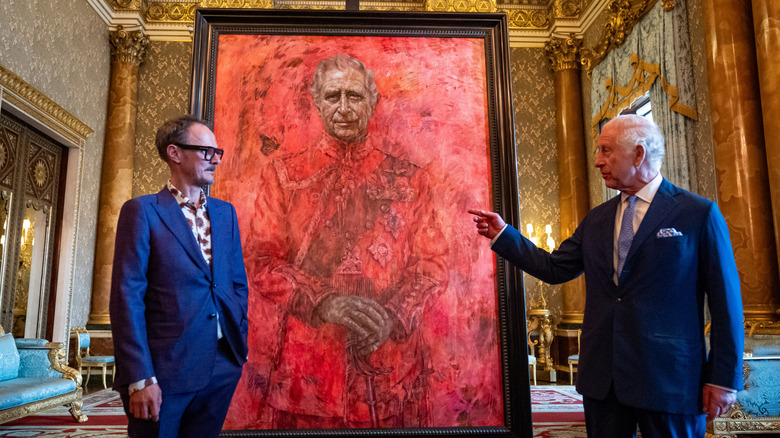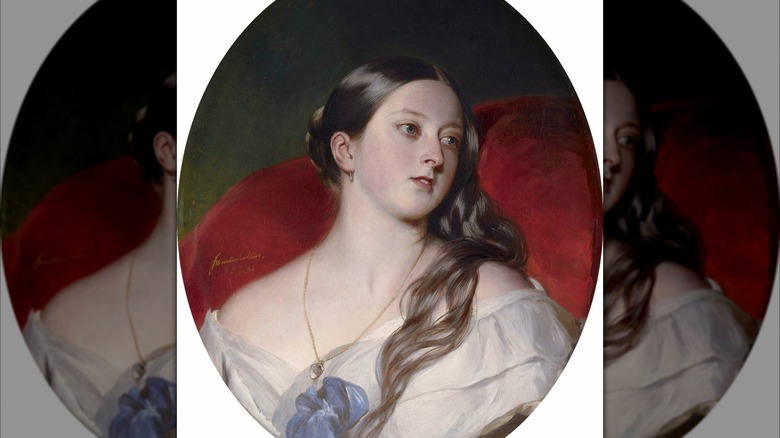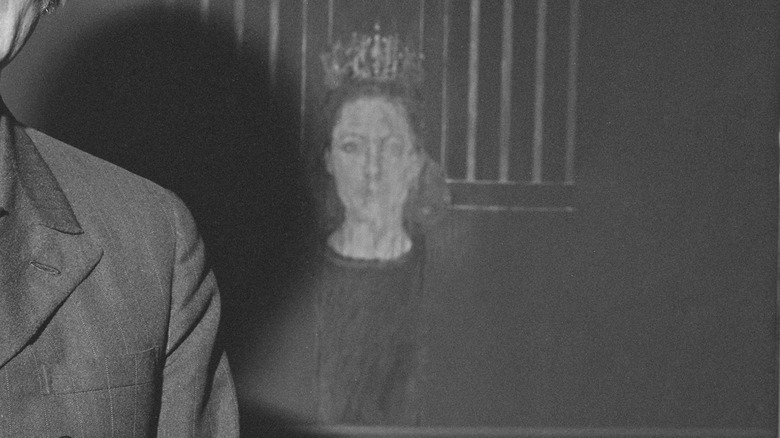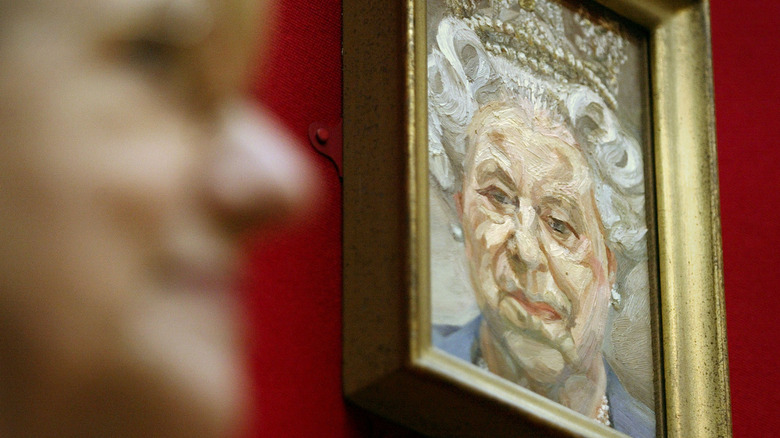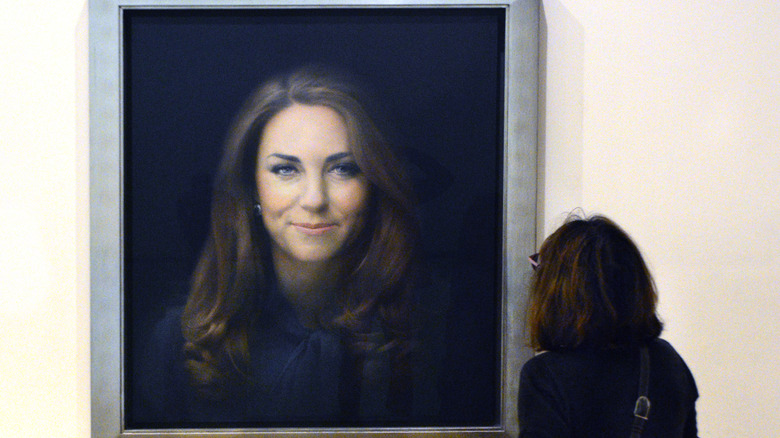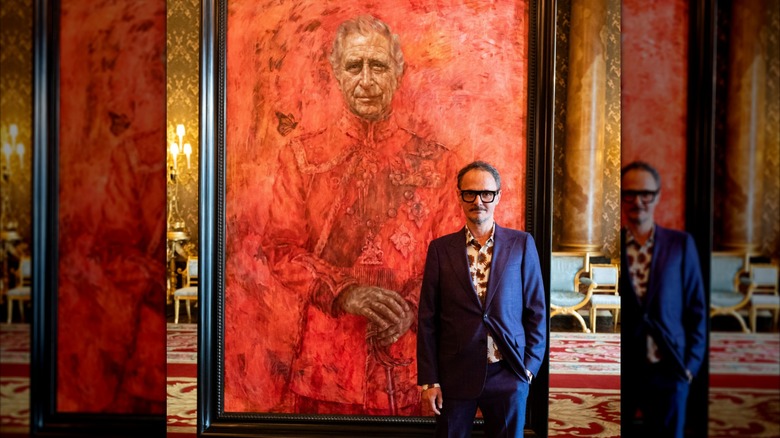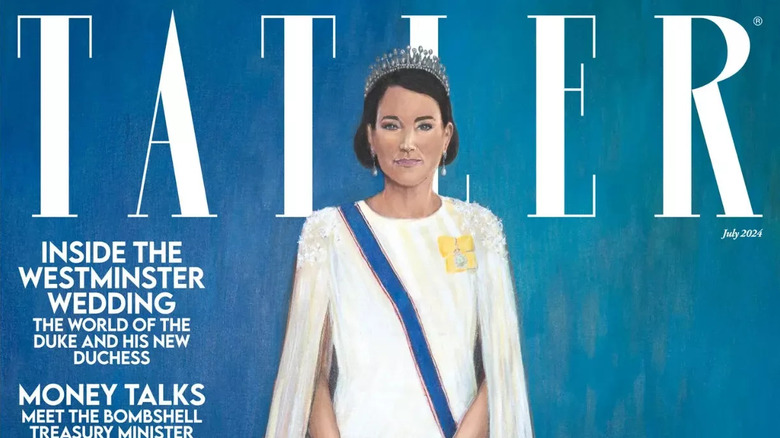The Most Controversial Royal Portraits That Had The World Buzzing
From state visits to Trooping the Colour, royal appearances are a spectacle in their own right. Each time a royal steps out in public, they're greeted by swarms of onlookers eager to catch a glimpse of them in real life. That said, you probably won't be surprised to learn that royal fanfare is a phenomenon as old as the royal family itself. Long before the advent of cameras, the blue-bloods used painted portraits to capture and share their images with the public. As noted by DailyArt, some of the earliest royal portraits date back to the 16th century.
Royal portraiture isn't just a way to disseminate the royal image — it has also been used as a powerful political tool. In many royal portraits, monarchs wear decadent fabrics and priceless jewels to convey their wealth and power. In other instances, royal portraits depict tender moments between the sovereign and their family, thus making them appear wholesome and sympathetic to the world.
Nowadays, digital photography allows us to capture and view portraits with unprecedented quality; however, the royal family has remained loyal to the tradition of sitting for hand-painted portraits. The royal collection contains hundreds of portraits by some of the world's most celebrated artists. Although many royal portraits have been well-received by the public, some have ignited major controversies. From "inappropriate" images to downright bizarre depictions, these controversial royal portraits had everyone talking.
This portrait of King Henry VIII left little to the imagination
King Henry VIII ruled England from 1509 until his death in 1547. This monarch has a particularly brutal claim to fame: he was married six times and had two of his wives executed. However, Henry's tumultuous love life wasn't the only stain on his reputation. His reign was also marked by political upheaval and religious turmoil between Catholics and Protestants. To make matters worse, Henry faced enormous public scrutiny over his struggle to produce a male heir. Thus, in 1537, the monarch commissioned a portrait of himself in a bid to regain control of his public image.
The oil painting was created by Hans Holbein the Younger, a prominent Swiss-German artist. It depicts Henry at his regal best, draped in jewels and looking quite brawny. While Holbein's work is truly striking, there's one detail that totally eclipses the rest: Henry's crotch is covered with a lavish decoration known as a codpiece. Henry's pelvic accessory is so large and flashy that it practically jumps off the canvas, drawing the viewer's eye straight to his nether regions.
In addition to his bulbous crotch, Henry's other bodily proportions are also exaggerated. As noted by Nerdwriter, Henry was in poor health during this time, and he wouldn't have looked nearly as muscular — or as well-endowed — in real life. According to historians, there's a pretty straightforward reason for these stylistic choices: Henry wanted this image to convey his authority and his hyper-masculinity to the world.
This portrait of Queen Victoria was deemed too 'alluring' for the public eye
Queen Victoria inherited the throne in 1837 and reigned for 63 years. During her lengthy queenship, she helped foster a new age of industrial growth, known as the Victorian Era. Victoria also had a fascinating personal life; in particular, she was famously devoted to her husband, Prince Albert. Despite being the sovereign, Victoria was adamant about sharing her royal duties with Albert. Thus, Albert played a critical behind-the-scenes role in shaping British society during the Victorian era.
In 1843, Victoria enlisted artist Franz Xaver Winterhalter to paint a private portrait of her as a birthday gift for Albert. In the oil painting, Victoria is seen reclining on a red pillow with her hair tumbling down in waves. She stares off into the distance, drawing the viewer's eye to her bare neck and shoulders. This image may seem tame by today's standards, but in Victoria's time, it was basically the equivalent of modern-day sexting. In her private diary, Victoria referred to it as "the secret picture."
Victoria died in 1901, but her "secret picture" remained hidden for many years to come. Originally deemed too "alluring," it wasn't displayed publicly until the latter half of the 20th century. To this day, the portrait is considered controversial because it portrays Victoria in a sensual light. This version of Victoria is a stark contrast to the stern, modest, matriarchal figure that we see depicted in other royal portraits.
This 1970 portrait of Princess Margaret was called 'grim' and 'ghostly' by naysayers
Princess Margaret was the younger sister of Queen Elizabeth II, but thanks to the rules of royal succession, she was never in the running to become queen. Free from the pressures of being an heir apparent, Margaret became known for her artsy, rebellious persona. In 1970, the art-loving royal caused an uproar when she posed for an avant-garde portrait that left some viewers aghast.
The controversial painting was created by British artist Bryan Organ. It features Margaret seated against a slate-colored background with gray vertical lines behind her. Her expression is blank, and half of her face appears to be fading away. Speaking with the New York Times, Organ explained that his aim was to paint Margaret "in a way that reflected the age she lived in."
Unfortunately, Organ's work didn't resonate with some onlookers. Critics slammed the painting, calling it "grim" and "ghostly." In a scathing review, the Daily Mail proclaimed, "The Princess looks like a tragic Tudor Queen awaiting execution." Despite the swarm of criticism, some experts viewed Organ as a visionary for shaking up the status quo on royal portraiture. "This is a remarkable moment," art historian Dr. Roy Strong told the New York Times. "This is the first time that a member of the royal family has agreed to sit for a portrait in the modern [era]. This shows great courage on the part of the Princess."
Artist Justin Mortimer was criticized for making Queen Elizabeth II look 'decapitated' in this portrait
Queen Elizabeth II was just 25 when she ascended the throne in 1952. Throughout the years, Queen Elizabeth's stunning transformation was immortalized by hundreds of artists, including legends like Andy Warhol and Annie Leibovitz. And while some portraits of Elizabeth have been widely celebrated, others have sparked serious controversy. In the late 90s, artist Justin Mortimer was chosen by the Royal Society for the Arts to create a portrait of the monarch. Channeling his surrealist style, Mortimer painted an image of Elizabeth seated against a bright yellow background. She's wearing a green dress that fades into pixels and her head is suspended above her body.
When Mortimer unveiled his work, it received a mélange of praise and criticism. In one review, the BBC declared that Elizabeth looked "decapitated, albeit on canvas, by her latest portrait painter." On the other hand, some viewers argued that the painting presented a fresh, unpretentious version of the queen, who is often portrayed as a godlike figure. As for Mortimer himself, the artist said he was proud of his work and what it stood for. "I wanted to get away from the royal aspect and paint a picture of a person rather than the Queen," he revealed. "It means people can focus more on the abstract quality of the painting and get away from the normal paintings of royalty, where everything is intact and, dare I say it, sycophantic."
Watchers were utterly perplexed by this rendering of Queen Elizabeth II
In the early 2000s, Queen Elizabeth II was immortalized on canvas by British artist Lucian Freud. The portrait reportedly took 19 months to complete — and at 15 x 23 centimeters, it was miniscule by royal portrait standards. Freud's work showed the queen gazing forward with a diamond crown atop her gray curls. Adhering to his signature style, Freud used a plethora of brush strokes and hues, adding a sense of depth and motion to the image. When the artist unveiled his work to the queen, she purportedly said (via The Guardian), "Very nice of you to do this. I've very much enjoyed watching you mix your colors."
Unfortunately for Freud, the press had a lot to say about his portrait — and some of the buzz was quite harsh. For example, art critic Robert Simon slammed the artwork, writing (via Belfast Telegraph), "It makes her look like one of the royal corgis who has suffered a stroke." Another journalist for The Daily Telegraph proclaimed that Freud's depiction of the queen was "extremely unflattering" (via the Washington Post).
Nonetheless, some viewers heralded Freud's portrait as a work of artistic genius. In the aforementioned article for The Guardian, journalist Adrian Searle declared, "This is the only painted portrait of the Queen, or any other member of the current royal family, of any artistic or indeed human merit whatsoever. It is probably the best royal portrait of any royal anywhere for at least 150 years."
This 'inappropriate' portrait of Prince Philip was banned by the Royal Society of Arts
The royal family may be rooted in centuries of tradition, but even the ritual-loving royals have been known to occasionally skirt conventions when it comes to portraiture. Case and point: Prince Philip, the husband of Queen Elizabeth II, once sat for a painting that was deemed too "inappropriate" for public display.
The debacle started in 2003 when artist Stuart Pearson Wright was enlisted by the Royal Society of Arts (RSA) to paint the Duke of Edinburgh. Known for his campy, absurdist work, Wright added a bit of whimsy and caricature to his portrayal of the famously stern prince. In Wright's painting, Philip is depicted with a long face, a gigantic nose, and a curmudgeon-y stare. His hairy chest is exposed and a fly rests on his shoulder. He raises his index finger to show a patch of clovers sprouting from his fingertip.
Unfortunately, the RSA balked at the painting, and it was subsequently banned from their archive. A year after its creation, the portrait finally saw the light of day when it was displayed at a gallery in London. Wright opened up about the experience in a 2024 Instagram post. "I feel deeply ambivalent about this painting," the artist wrote. He added, "The Royal Society of Arts who commissioned this, told me to shove it where the sun didn't shine and I had to make another version for them: just a head. I still can't work out what their objection was."
Princess Catherine's first royal portrait gave some viewers a jump scare
Princess Catherine joined the royal family in 2011 when she married Prince William. Since then, the stunning transformation of Princess Catherine has continued to enthrall royal watchers. Thus, when the regal sat for her first official portrait in 2012, fans were eager to see the final result. Catherine's inaugural portrait was created by artist Paul Emsely, and it features a lifelike image of the princess against a black background. Speaking with BBC in 2013, Emsely revealed that he spent several months completing the piece.
When the artwork went public, some viewers felt a touch of the heebie jeebies. Noting the bleak background and Catherine's intense expression, critics felt it looked less like a royal portrait and more like an image from Dracula's castle. In some cases, Catherine's portrait sparked harsh comparisons to characters from the "Twilight" franchise. Writing for The Guardian, journalist Charlotte Higgins described Catherine's eyes as "dead" and "malevolent." Art critic Waldemar Januszczak also chimed in, stating that the portrait lacked creativity. He wrote (via BBC): "In the end it's yet another pretty ordinary painting of a royal of the sort that we've been really churning out for the last few hundred years in Britain."
In response to the controversy, Emsley shrugged off the naysayers. "I tried my best," the painter told BBC. "Inevitably it's not to everyone's taste, I understand that."
Artist Jonathan Yeo caused an uproar when he painted King Charles III in 2023
Despite being in the limelight for his entire life, King Charles III isn't exactly a pro at managing his public image. From his years-long feud with Prince Harry to his most controversial moments as king, Charles has weathered plenty of PR disasters in his time. However, in 2024, the regal faced controversy from an unlikely source when his portrait sparked an internet frenzy.
The offending portrait was painted by British artist Jonathan Yeo. In the painting, Charles stands front-and-center wearing crisp military regalia. The background is awash with vibrant strokes of pink, red, and yellow that bleed into his uniform. According to Yeo, Charles and Queen Camilla were delighted when they saw the finished product. Unfortunately, the public wasn't nearly as gracious with their opinion. Photos of the artwork went viral on social media, and a massive debate ensued.
While some viewers admired the piece, others railed against it. Journalist Sebastian Smee condemned Yeo's work, calling it "confused, obsequious, oversized and unaccountably frightening" (via the Washington Post). Some critics noted that the reddish background looked like hellfire, while others compared it to blood. In July 2024, Yeo opened up about the situation to GQ. "I had some idea it was going to be a newsworthy thing, but didn't anticipate just how crazily it would go around the world," the artist shared. He added, "You suddenly realize the thing you've created is not yours anymore — it represents different things to different people."
Critics thought this portrait of Princess Catherine was downright 'dreadful'
Given her celebrity status, there's nothing inherently controversial about Princess Catherine being featured on a magazine cover. However, that changed in July 2024 when British magazine Tatler published a deeply polarizing portrait of the regal. The portrait was created by a British-Zambian painter named Hannah Uzor. In Uzor's interpretation, Catherine stands against a blue background wearing a white gown and the famous Lover's Knot tiara.
When creating the portrait, Uzor faced an interesting challenge: she'd never actually seen Catherine in person. Instead, she observed countless photos of the princess and tried to channel certain aspects of her personality. The artist told Tatler: "When you can't meet the sitter in person, you have to look at everything you can find and piece together the subtle human moments revealed in different photographs."
Unfortunately, some viewers didn't see the vision. When Tatler released the portrait on social media, it was met with a storm of controversy. Some critics complained that the portrait didn't resemble Catherine at all, while others simply called it "dreadful." However, beauty is in the eye of the beholder, and not everyone disapproved of Uzor's work. For example, one Instagram user wrote, "I like it, she looks beautiful and young and really natural." Another fan chimed in, writing, "Please don't bite my head off but I like it, and I like this artist's style!"
